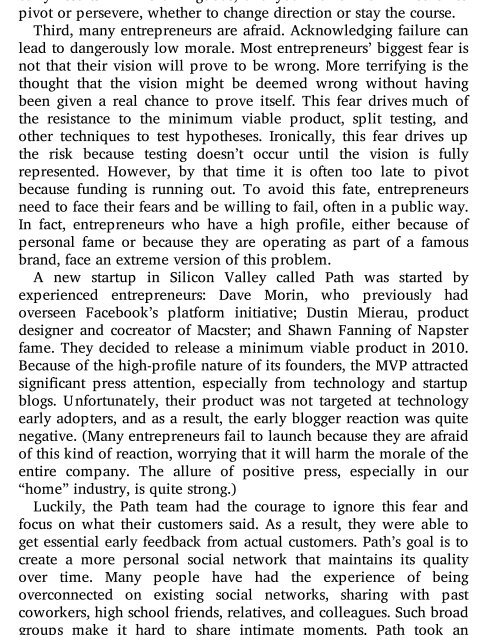Acclaim for THE LEAN STARTUP
The Lean Startup: How Today's Entrepreneurs Use Continuous ...
The Lean Startup: How Today's Entrepreneurs Use Continuous ...
- No tags were found...
Create successful ePaper yourself
Turn your PDF publications into a flip-book with our unique Google optimized e-Paper software.
pivot or persevere, whether to change direction or stay the course.<br />
Third, many entrepreneurs are afraid. Acknowledging failure can<br />
lead to dangerously low morale. Most entrepreneurs’ biggest fear is<br />
not that their vision will prove to be wrong. More terrifying is the<br />
thought that the vision might be deemed wrong without having<br />
been given a real chance to prove itself. This fear drives much of<br />
the resistance to the minimum viable product, split testing, and<br />
other techniques to test hypotheses. Ironically, this fear drives up<br />
the risk because testing doesn’t occur until the vision is fully<br />
represented. However, by that time it is often too late to pivot<br />
because funding is running out. To avoid this fate, entrepreneurs<br />
need to face their fears and be willing to fail, often in a public way.<br />
In fact, entrepreneurs who have a high prole, either because of<br />
personal fame or because they are operating as part of a famous<br />
brand, face an extreme version of this problem.<br />
A new startup in Silicon Valley called Path was started by<br />
experienced entrepreneurs: Dave Morin, who previously had<br />
overseen Facebook’s plat<strong>for</strong>m initiative; Dustin Mierau, product<br />
designer and cocreator of Macster; and Shawn Fanning of Napster<br />
fame. They decided to release a minimum viable product in 2010.<br />
Because of the high-prole nature of its founders, the MVP attracted<br />
signicant press attention, especially from technology and startup<br />
blogs. Un<strong>for</strong>tunately, their product was not targeted at technology<br />
early adopters, and as a result, the early blogger reaction was quite<br />
negative. (Many entrepreneurs fail to launch because they are afraid<br />
of this kind of reaction, worrying that it will harm the morale of the<br />
entire company. The allure of positive press, especially in our<br />
“home” industry, is quite strong.)<br />
Luckily, the Path team had the courage to ignore this fear and<br />
focus on what their customers said. As a result, they were able to<br />
get essential early feedback from actual customers. Path’s goal is to<br />
create a more personal social network that maintains its quality<br />
over time. Many people have had the experience of being<br />
overconnected on existing social networks, sharing with past<br />
coworkers, high school friends, relatives, and colleagues. Such broad<br />
groups make it hard to share intimate moments. Path took an




